This is what the economy of the Amazon…
10 July, 2024
Wednesday 02 june 2021
Header photo by Guyra Paraguay Estación Los Tres Gigantes – Río Palmar
Over the course of five years, SRJS strengthened the capacities of 191 CSOs in the fields of, inter alia, business and financial institutions engagement, L&A, environmental law, innovative monitoring methods and strategic environmental assessments.
The main lesson learned is that capacity strengthening is most effective when learning is drawn from practice, informed by real-life problems, solutions and opportunities, and involves a diversity of stakeholders.

Over the past five years, civic space has decreased in many countries across the globe. Some CSO partners have been threatened and, tragically, even killed. SRJS enabled CSO partners to defend their space by providing improved safety protocols and emergency funds for Environmental Human Rights Defenders. The programme also contributed to increased awareness of the importance of gender mainstreaming across all participating CSOs and at community level. The final evaluation concluded that SRJS paid adequate attention to the issue of gender and that both Indigenous People and Local Communities and women increased their participation in development processes.
The SRJS programme resulted in a diverse range of partnerships and networks. SRJS increased the capacity and confidence of its CSO partners to both participate in and facilitate partnerships and networks. Partnerships were established across the national CSO movement, with communities and government authorities. Engaging with businesses in a meaningful way proved more difficult; not all businesses are open to dialogue on how to secure ecosystem services. Where engagement was successful, this was largely due to commitment from local business units. The main lesson learned is that collaboration and dialogue on the landscape level requires time and trust, but when successful, it stimulates innovation in conservation, natural resource management and joint sustainable development.


Natural ecosystems are better protected when government and corporate policies & practices are inclusive and green. SRJS’s L&A efforts led to 1116 examples of change to policies and practices by government agencies, businesses and communities (see Highlights Outcome Harvesting publication below this article). These changes in policies and practice contributed to the following impact, the development and adoption of operational plans for integrated water resources management for 510.000 hectares of river basin; 2.669.000 hectares of forest land under improved sustainable forest management, leading to decreased deforestation; and 97.000 hectares of sustainable food production systems. Achievements in biodiversity protection were accomplished indirectly; watershed, forest or wetland protection securing critical habitat for 383 endangered species. The final evaluation concluded that the programme contributed to the protection and enhancement of ecosystem-based IPGs, mostly related to food and water security.
Various studies and evaluations of the programme governance provided useful insights on programme coherence, southern ownership and leadership, collaboration among the alliance members, adaptive management, outcome harvesting and ecosystem impact monitoring. SRJS upheld a decentralised approach, tailored to the specific country contexts, landscapes and the needs of the CSOs. This resulted in strong ownership and autonomy of partners in the implementation of their country and landscape programmes. The overall steering of the programme remained northern-led, managed by a steering group that was based in the Netherlands. One of the major recommendations of the final evaluation was, unsurprisingly, that the design of any new programme should include southern CSOs from the outset in the design and the overall steering of the programme.
SRJS set out to strengthen the capacities of southern non-governmental organisations, but evaluations reveal that the capacities of the northern partners were equally strengthened as the programme progressed. All partners have learned lessons on inclusive conservation, gender and social inclusion, the landscape approach, how to influence the private sector and transform funding mechanisms, on citizen science, civic space and leadership. Empowerment is very important, but empowering people on how to protect nature, its forest, rivers, wetlands and seas and sustain this beautiful planet, has maybe been the most important lesson of all, for all partners.
Header photo by Guyra Paraguay